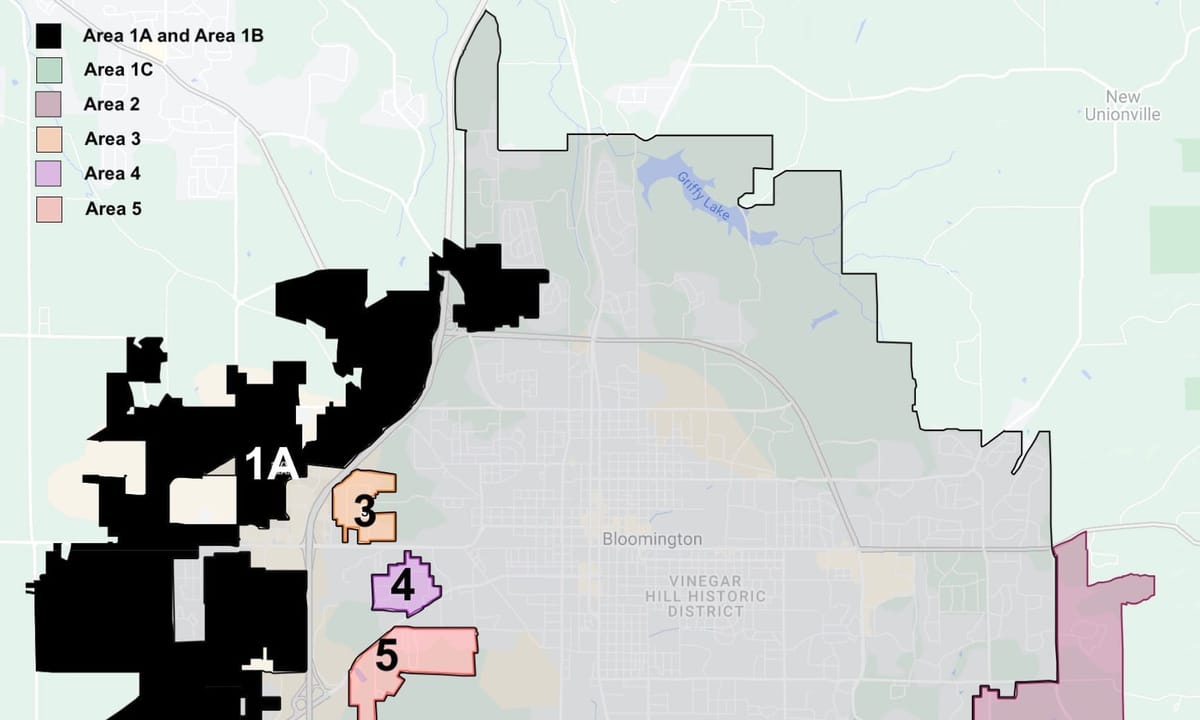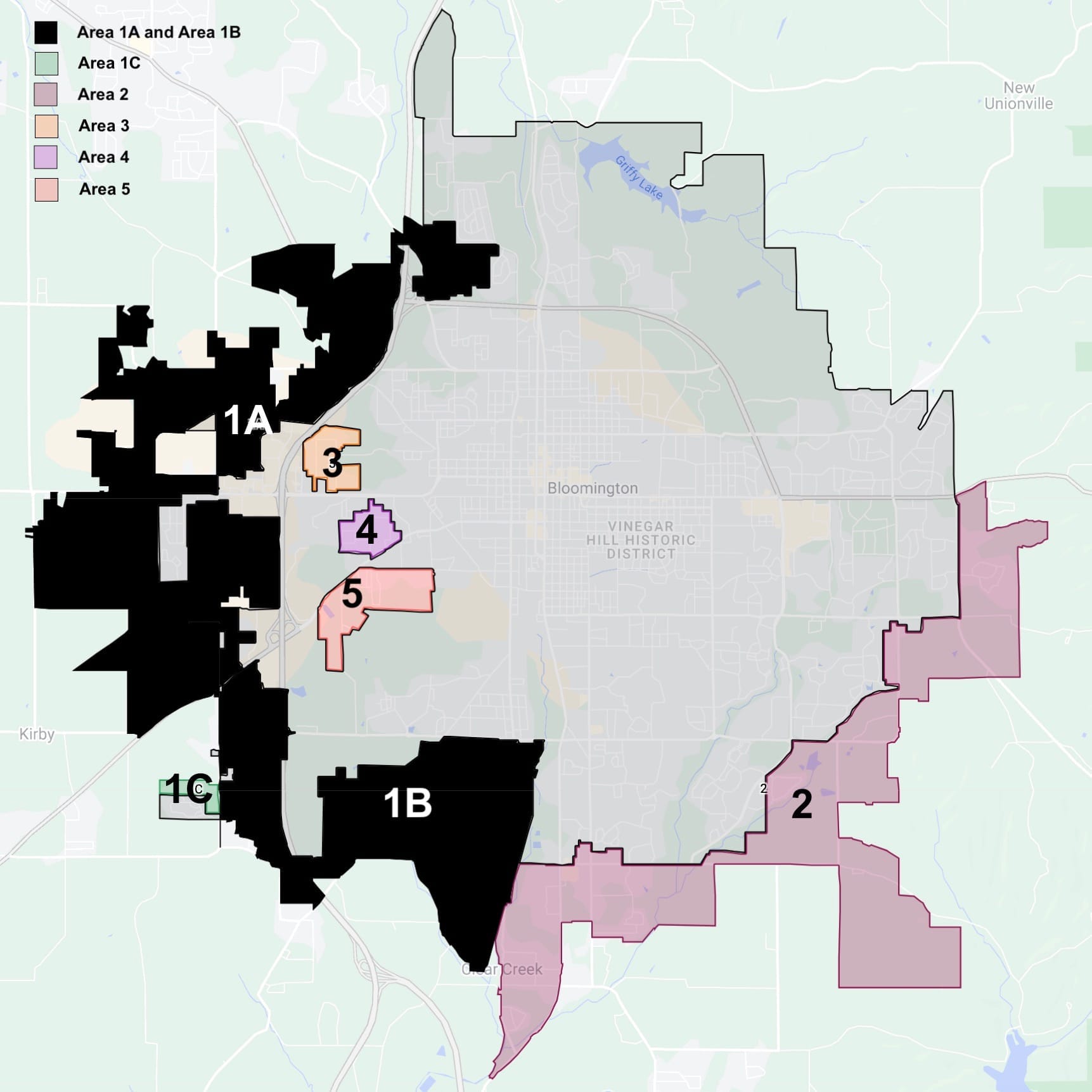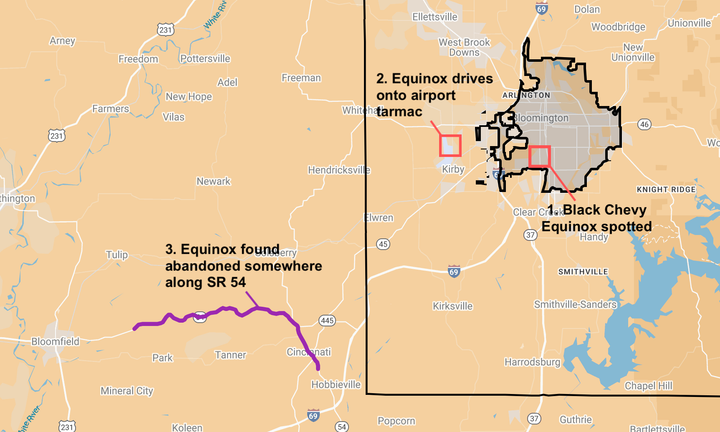Indiana Court of Appeals upholds ruling against Bloomington in annexation of 2 areas
The Indiana Court of Appeals has affirmed a Monroe County Circuit Court ruling that blocked Bloomington’s attempt to annex two large pieces of land—Areas 1A and 1B—after finding the city failed to meet state statutory requirements for annexation.


A three-judge panel on the Indiana Court of Appeals has affirmed a Monroe County Circuit Court ruling that blocked Bloomington’s attempt to annex two large pieces of land—Areas 1A and 1B—after finding the city failed to meet state statutory requirements for annexation.
The areas are on the west and southwest sides of the city, and are home to over 10,000 residents based on the city’s most recent calculations.
In a unanimous opinion issued Wednesday (Sept. 24), Leanna Weissmann, wrote for a panel that included judges Elaine Brown and Mark Bailey. Weissmann concluded that the trial court judge, Nathan Nikirk, did not misconstrue annexation law, when he found that the city’s 2021 ordinances did not meet statutory requirements.
Oral arguments in the case were held Aug. 19 in Indianapolis.
The opinion released on Wednesday recounts a long legal and political battle over Bloomington’s annexation plans, stretching back to waivers signed decades ago, legislative intervention in 2017 and 2019, and a five-day bench trial last year in Monroe Circuit Court in front of special judge Nathan Nikirk.
Petitions against annexation (remonstrances) were signed by more than half of property owners in each of the two areas. After the state legislature voided many of the city’s old remonstrance waivers with a law enacted in 2019, about 61% of landowners in Area 1A and 57.5% percent in Area 1B successfully opposed annexation. That was enough to earn judicial review, but not enough to stop the annexation outright.
For this case, the status of the petitions was not at issue, because the city of Bloomington waived any constitutional arguments involving the petitions for Area 1A and Area 1B. In the other areas subject to the city’s annexation efforts, the city of Bloomington is separately pursuing a case based on the idea that the nullification by the legislature of annexation waivers violated the contracts clause of the Indiana state constitution. For that separate litigation, oral arguments are to be heard by the Indiana Supreme Court on Oct. 30.
Last year, after the bench trial, Nikirk found that Bloomington had not proven either of the statutory “pathways” to annexation—showing either urban character or a need for development in the reasonably near future. It also determined that annexation would have a “significant financial impact” on landowners and was not in their best interests.
Weissmann’s appellate opinion echoed those findings. She rejected the city’s proposed “hybrid” method of calculating population density and zoning percentages.
The court of appeals also agreed with the trial court’s conclusion that property owners would face steep tax increases. Residents of Area 1A, if annexed, would pay more than $11 million in additional property taxes in the first four years. The figure would be $9 million for Area 1B residents, which is an overall increase of about 40%, both courts concluded.
On the question of whether annexation was in the best interests of property owners, the court pointed to testimony that residents were generally satisfied with existing county government services, while Bloomington’s police, public works, and transit systems were already stretched thin.
Summing up the opinion, Weissmann stressed the limited role of the court in an annexation case by citing a precedential case: “The judicial role [in annexation cases] is to decide whether the municipality has met the statutory requirements or flouted them. Courts may do no more; but we must do that much.”
The Sept. 24 ruling leaves intact Nikirk’s August 2024 judgment stopping Bloomington’s annexations. There’s no word yet from Bloomington mayor Kerry Thomson’s office on whether the city will ask the Indiana Supreme Court to accept the case.
The other parts of Bloomington’s annexation effort are still in litigation, based on a challenge to the 2019 state law that voided remonstrance waivers. That will be heard by the Indiana Supreme Court on Oct. 30.
Added Sept. 25, at 2:12 p.m. The city has issued the following statement in response to the ruling:
The City of Bloomington is disappointed with the recent decision by the Indiana Court of Appeals denying Bloomington’s annexation of adjacent urban areas, which were developed through City services and with the agreement and understanding that the areas would one day become part of the City.
As the Court of Appeals’ decision recognizes, Bloomington’s annexation effort “has a protracted and complicated background strewn with lawsuits, special legislation, and related appeals, one of which remains pending in our Supreme Court.”
Research shows that if Bloomington is unable to capture the intentional growth adjacent to its boundaries, the region and community will experience a long-term decline in population, household income, economic growth, and fiscal health of the community.
Mayor Kerry Thomson is committed to advancing the interests of Bloomington and the surrounding area, stating “Bloomington is a cornerstone in the economic prosperity of our region and must be afforded the tools to make our region strong and vibrant.”
Bloomington will seek transfer to the Indiana Supreme Court, with the intent of reaffirming the long-established preference to permit the annexation of adjacent urban areas that have a lasting impact on the City’s services, and the surrounding population. This is a vital matter not only for the City, but for other municipalities across the State.




Comments ()